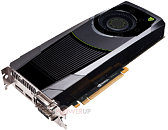- Joined
- Oct 9, 2007
- Messages
- 47,684 (7.42/day)
- Location
- Dublin, Ireland
| System Name | RBMK-1000 |
|---|---|
| Processor | AMD Ryzen 7 5700G |
| Motherboard | Gigabyte B550 AORUS Elite V2 |
| Cooling | DeepCool Gammax L240 V2 |
| Memory | 2x 16GB DDR4-3200 |
| Video Card(s) | Galax RTX 4070 Ti EX |
| Storage | Samsung 990 1TB |
| Display(s) | BenQ 1440p 60 Hz 27-inch |
| Case | Corsair Carbide 100R |
| Audio Device(s) | ASUS SupremeFX S1220A |
| Power Supply | Cooler Master MWE Gold 650W |
| Mouse | ASUS ROG Strix Impact |
| Keyboard | Gamdias Hermes E2 |
| Software | Windows 11 Pro |
After GeForce GTX 680, which has all components of the 28 nm GK104 enabled, a dual-GPU GeForce GTX 690, which features two of these chips, and the GeForce GTX 670, NVIDIA is readying its third single-GPU GK104-based SKU. We know from older reports that this SKU could be named GeForce GTX 660 (Ti). A fresh report suggests that it will be carved out by disabling an entire graphics processing cluster (GPC) on the GK104 silicon, resulting in a CUDA core count of 1152; reducing the memory bus width of 192-bit GDDR5; and most likely reducing the ROP count to 24. This SKU could be used to capture a price point of around US $249, targeting AMD's Radeon HD 7800 series.

View at TechPowerUp Main Site

View at TechPowerUp Main Site





 i think it would better if it was 256bit.
i think it would better if it was 256bit.

